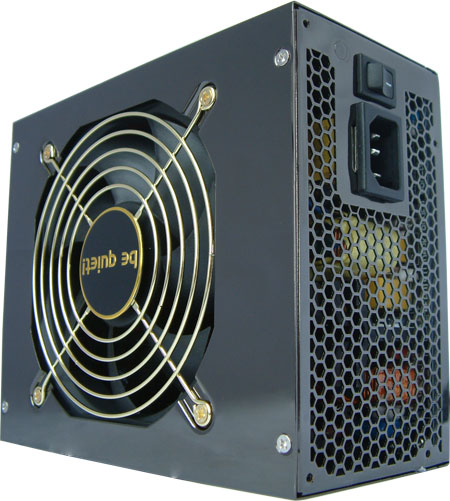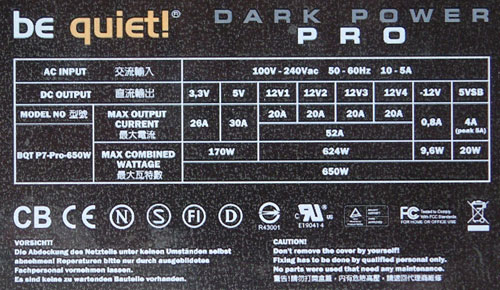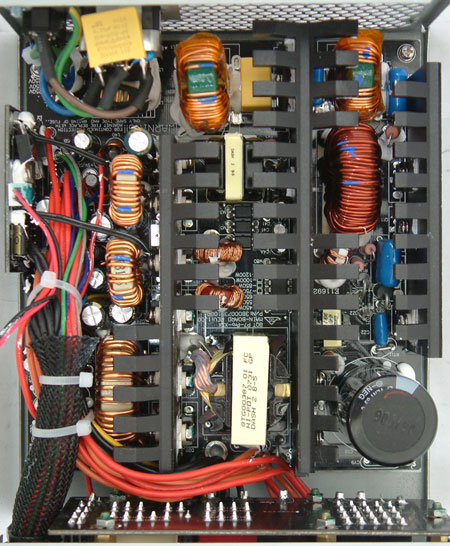Power Supply Roundup: 650W-680W
by Christoph Katzer on February 21, 2008 2:00 AM EST- Posted in
- Cases/Cooling/PSUs
Be
quiet! Dark power PRO P7 650W

be quiet! (Ed: yes, the lowercase and exclamation point are the correct way to spell the name) is a brand most of our readers likely have not encountered. The company is in Germany, where their largest customer base is located, and we first mentioned be quiet! in our power supply summary in December 2007. be quiet! offers unique service to its customers. If a power supply experiences any malfunction, they will send someone to collect the power supply and deliver a brand new one within 48 hours. The company offers this service in France and Poland as well, but unfortunately they are not shipping units to the US and thus that level of support is not available.
Their power supplies all have a similar look, with a dark glossy appearance. The P7 series is the seventh model of the existing Dark Power PRO series that first came to market around 2002. The power supply comes in a nice finish and a golden fan grill. Note that the 180mm housing is quite long and will cause incompatibilities with some smaller cases.

The be quiet! Dark Power PRO comes with four 12V rails rated at 20A. The total combined power however remains the same as other units today: up to 52A or 624W. The 3.3V rail is rated at 26A and the 5V rail at 30A. Together they can pull up to 170W, which is an average load. Keep in mind that most systems will rarely require more than a couple hundred watts of power, unless you are running multiple graphics cards with a heavily overclocked CPU.

The Dark Power PRO comes with lots of cables, giving the user a variety of options. With a minimum length of over 60cm, even users with larger cases should not have any difficulties getting the cables to all the required areas. All the cables are sleeved in black all the way to the connectors, completely obscuring any view of the cables. Noteworthy features include the four harnesses that each have a 3-pin and a 4-pin Molex connector, which users can connect to case fans and allow the power supply to control fan speeds.

Opening this very long power supply, we find three long and thin heatsinks. The fins have a decent separation, which is good for airflow to the PCB components. be quiet! doesn't appear to waste much space in this long housing, but it is actually used for all their models from 450W up to 1200W. Even with a smaller 650W rating, the PCB is full of components. Since the manufacturer uses this chassis for their whole range of PSUs, the length makes some sense even if it's not really necessary. It's a matter of optimizing certain manufacturing and cost aspects, leaving them free to focus on other areas like quality. Still, the question of case incompatibility remains, and it's difficult to imagine someone purchasing a 450W PSU with the intention of buying a full-size ATX case.










23 Comments
View All Comments
larson0699 - Monday, August 4, 2008 - link
You mentioned that the label on the Thermaltake unit doesn't state maximum combined load of the lower-volt rails.But look, it does. 180 Watts.
BRDiger - Tuesday, July 29, 2008 - link
I kind a wondering because comparing the efficiency level of the Be Quiet! to the testing datasheet on the 80plus.org site it just reaches about 80% at 100% load unlike your results with nearly 84%. Comparing it to the Enermax Modu 82+ review here, it even exeeds its efficiencyJust wondering and it´s not supposed to be an offence...
BRDiger - Tuesday, July 29, 2008 - link
Well, after reading another review it seems that 80plus was actually wrong and the be quiet!s performance exeeds the enermax..strikeback03 - Friday, February 22, 2008 - link
Thermal and fluids was not my best subject in school, but don't fans usually lose air off the tips of the blades, not suck it in? That is my experience with the Zerotherm Nirvana, which seems to make the same claim of sucking air in with its open fan.mo3 - Friday, February 22, 2008 - link
The new Enermax Modular 82+ & Pro 82+ can peak over 700Watts with out a problem; also they have the ATX12v V2.3 and reaching 88% efficiency.Modular 82+ has 2x 12 pin connection embedded for up and coming graphics cards and greater stability.
Just to give the readers a better alternative! :)
Check out more info at: www.enermax.co.uk
crimson117 - Friday, February 22, 2008 - link
Okay... PSU review.. new 9600 GT review... I think anandtech is trying to tell me I need a new computer!NINaudio - Thursday, February 21, 2008 - link
Hi, you mention that the be quiet! PSU is quiet but also runs warmer than the others. Where are the temperature charts that we've seen in previous PSU reviews? It would be good to see the temperatures that you sacrifice for a quieter PSU. Is it a degree, 5 degrees, ten degrees, more?tynopik - Thursday, February 21, 2008 - link
1. include a real stress test like how the units handle rapidly changing input voltagesay load them up to 80% capacity and then connect them to a variac and dip the voltage to ~90V 3 times in quick succession to simulate a brownout or poor electrical conditions and check that
a) it doesn't blow up
b) it maintains quality output while the input if fluctuating
2. include cheapo units for comparision just for the reminder of what a poor quality unit is
3. i really love your connector length charts, far more useful than the usual 'stetch a jumble of cables out and lay a ruler next to it' approach. i just wish you would do the same for the sata/peripheral connectors
4. i'm really like the way you combined all the acoustic and efficiency charts together instead of having a bunch of individual charts
Christoph Katzer - Thursday, February 21, 2008 - link
I just assembled a nice system do to those tests. Once it's up and running I will include it. Will also make a comparison of all cables from now on, thanks.The problem with cheap units is that they are mostly for a specific market. I would need to buy thise units myself since no company would ever send them over. Since I am not in the US I will only have the stuff from Europe which is not even available in the US. But let us see how we could change that in the future...
jtleon - Thursday, February 21, 2008 - link
Chris,You state that at least 100W must be drawn before these units achieve high efficiency. Can you relate this requirement to most normal PC tasks - i.e. browsing the web (reading Anandtech reports of course), answering email, other office based activities (the majority of PC users on the planet), rather than those hardcore gamers that are gaming around the clock (and clearly are independently wealthy!).
It would appear that these PSU's are not going to efficiently reduce the carbon footprint of the majority of PC users on this planet.
Am I wrong?
Regards,
jtleon